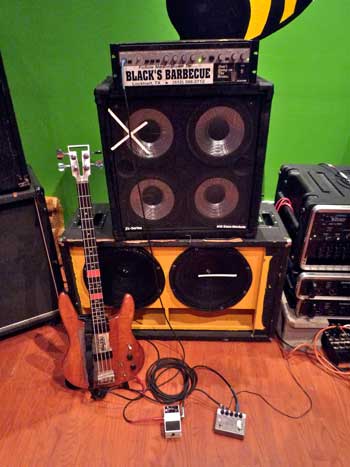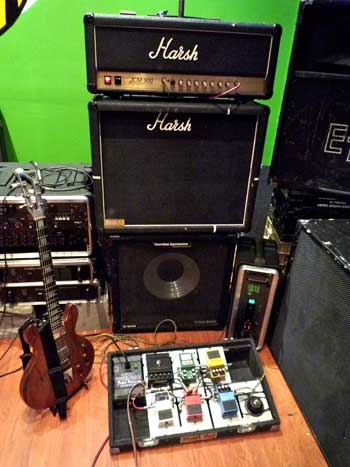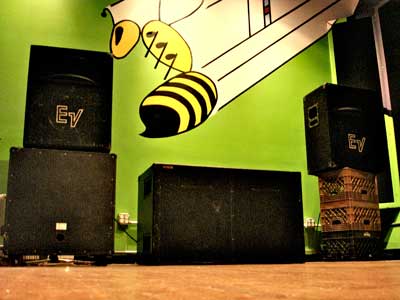|
03.30.09
EP Pre-production - Overview
We are almost finished writing our next release - a four song EP. While we iron the last bits out and practice the songs, Justin (that's me) has some time to get ready for the actual recording. We'll be keeping track of the progress along the way.
We are a straightforward band when it comes to recording. Overall, we like to give the impression that the listener is in the room listening to us playing these songs live and loud. There are some deliberate deviations from this, or else we'd just set up a really nice stereo mic in the room, set the levels and play all four songs. We'll make note where we're moving away from the purist position.
There are some common things we want to avoid. Minimal compression overall - since so much of the guitar and bass are compressed through the overdriving part of their signal chain, keeping the rest of the dynamic range intact is important. (That is, don't bring everything up to sound loud coming out of your speakers - let the loud parts of songs be loud, let the quiet parts be quiet.) (Hmm, maybe that explanation doesn't really clear anything up. Oh well.) No changing instrument sounds in a song unless the sound also changes when we play it live. No double/triple/multi tracking of any instrument. Other than what's already part of the drum machine's sounds, no artificial reverb on anything. Avoid dialing in EQ changes - the tonal presentation of a sound should be the appropriate choices made in mic selection and position, pre-amp choice and that's about it. Finally, the mixing should probably just be setting the relative levels of the instruments, rewinding to the beginning of the song and playing it back without changes.
There are four records that will for sure be refenced as we pull this thing together. They should give you an idea of the impression we're aiming for:
- Slint: Spiderland
- PJ Harvey: Rid of Me
- Nina Nastasia: The Blackened Air
- Machito - Kenya
Here are the band details:
BASS
The bass sound is overdriven (but not "Streetcleaner" distortion) using the [ Rusty Box ], a stompbox based on the design of a solid state 70s Traynor amp. This is fed into a a bass amp that has two amplifier sections, allowing us to bi-amp the signal from the Rusty Box. This means we can set our own balance between the high frequency part of the signal (sent to a 4 x 10 cabinet) and the low frequency part (sent to a 2 x 15 cabinet). While the Traynors had a fairly thin low end, we tend to crank the 2 x 15s way up to give some real definition to the low frequency stuff.
The goal of the recording will be to give the LF (that's for low frequency, because I'm going to get sick of typing it out and don't want to confuse things by using the term bass unless I'm talking about the instrument) the physical presence it has when we're playing. It's also important that the notes be clear - there's a couple of parts in these songs where the bass really carries things; a sloppy presentation of the HF (high freqency) part of the signal will lose the definition that ties the song together.
GUITAR
The guitar moves from distorted to very, very distorted. The front end of the signal is the pedal board, really just a wonderfully primitive digital pitch shifter and a loop with three distortion pedals in series. This mess is run into an early 1990s Marshall JCM 900. While we use a Marshall 4 x 12 for support when we play live, the key part of the sound is the main biamped stack with a Marshall 2 x 12 handling the high end and a 1 x 15 taking the low end. The JCM 900 is known for giving an "icepick" type of distortion, and we take out all of the midrange while maxing out the presence, high and low on the amp's eq section. The 2 x 12 also has a much brighter sound than the 4 x 12.
With the amp, this cabinet and a pitch shifter all part of the signal, the recording needs to present the full range sound of the signal without making the listener's ears bleed from too much HF blare. This is a delicate task - with all of the distortion that's introduced into the sound, it's possible for subtle things (and they're there) to get lost amid the general roar. I've often thought it'd be cool to play guitar in a way that would just be a noisy assault with vague shifts from note to note. But when I've actually played like this, I get bored quick. Anyway, it's not what's happening with this band.
DRUMS
Much easier for us than it is for most, as we've got a drum machine that is reliable and does exactly what we tell it. While we've played around with different output configurations, we'll just be running a stereo signal output from the thing having had the relative levels of the different parts of the kit set on the drum machine. That is, if we want the snare to be louder, we'll have to sit down in front of the thing and click up the snare a couple of ticks. And then re-record it with the new settings.
When we play live, we play the thing through the house system as well as our own PA: two full-range cabinets and a 2 x 18 subwoofer. The kit has some pretty definite stereo presentation, with some cymbals and click noises nearly or fully hard-panned to one side or the other. (You may wonder about the toms - we don't even have them programmed into the machine.)
While we love our drum machine for its ability to sound like a doomsday device mercilessly pounding out a nightmare in 16th notes, it's most powerful when moving air in the room you're in. This means the recording should preserve some of the physical (there's that word again) sense of having that PA thunder right along in front of you. In other words, just running the stereo signal right onto tape isn't going to do it for us. We'll want to include some of the room sound mixed with it. We'll also need to pay attention to the volume of the crash cymbals. It's common to kind of bury them on heavy recordings. While we don't want their sound to wash out what's happening, there's a few parts of a few songs where their entrance and presence is critical. This balance will require attention throughout.
VOCALS
This is Justin. He sings/yells/screams in about equal parts on this, with his voice deliberately breaking from time to time in the songs. There's a decent dynamic range covered: a few parts that are quietly sung or spoken and a number of parts that are as loud as he can muster.
There are two main challenges for recording. First, past recordings have been thin on the LF part of the singing, making the vocals sound a bit weak. This may be a mic issue or something else. Point is, this recording should capture all of the LF coming through. Second, we really want to avoid squashing the vocals to death. While compression is inevitable (especially with the quiet/loud issues noted above), it should be as transparent as possible. A few songs will have an overdriven/distorted edge on the vocals, others will be clear. Justin is also paying much closer attention to phrasing and how the stuff sounds coming out of his mouth, but that's performance stuff, not really a technical issue.
Those are the constituent parts. Next up, I'll check in on what we've got to record this stuff with.
|
 |
 |
 |


Bass setup: Biamp amplifier on top, 4 x 10 below, 2 x 15 on the bottom. Bass is plugged into the Rusty Box, then a tuner.

Guitar setup: Marshall line out is run into biamp amplifier on right side. (Marshall power amp runs a 4 x12 not pictured. 2 x 12 below, 1 x 15 on the bottom. Guitar is run into pitch shifter, then distortion loop (three pedals on top part of pedalboard), then a tuner, then the amp.

Drum machine setup: Amps are somewhere else. The EVs are sitting on top of a guitar cabinet (left) and three milk crates (right) that I swear we paid for.
 < <
Vocalist setup: 1973 model, produced in Pittsburgh. Medium use.

|
 |
 |
 |
[ LATEST UPDATE ]
[ Archives ]
CONSTRUCTION
[ Overview ]
[ Basic Construction ]
[ Acoustics ]
[ HVAC ]
[ Electrical ]
[ The Grand Vision ]
[ Tool Reviews ]
[ Links and Resources ]
|